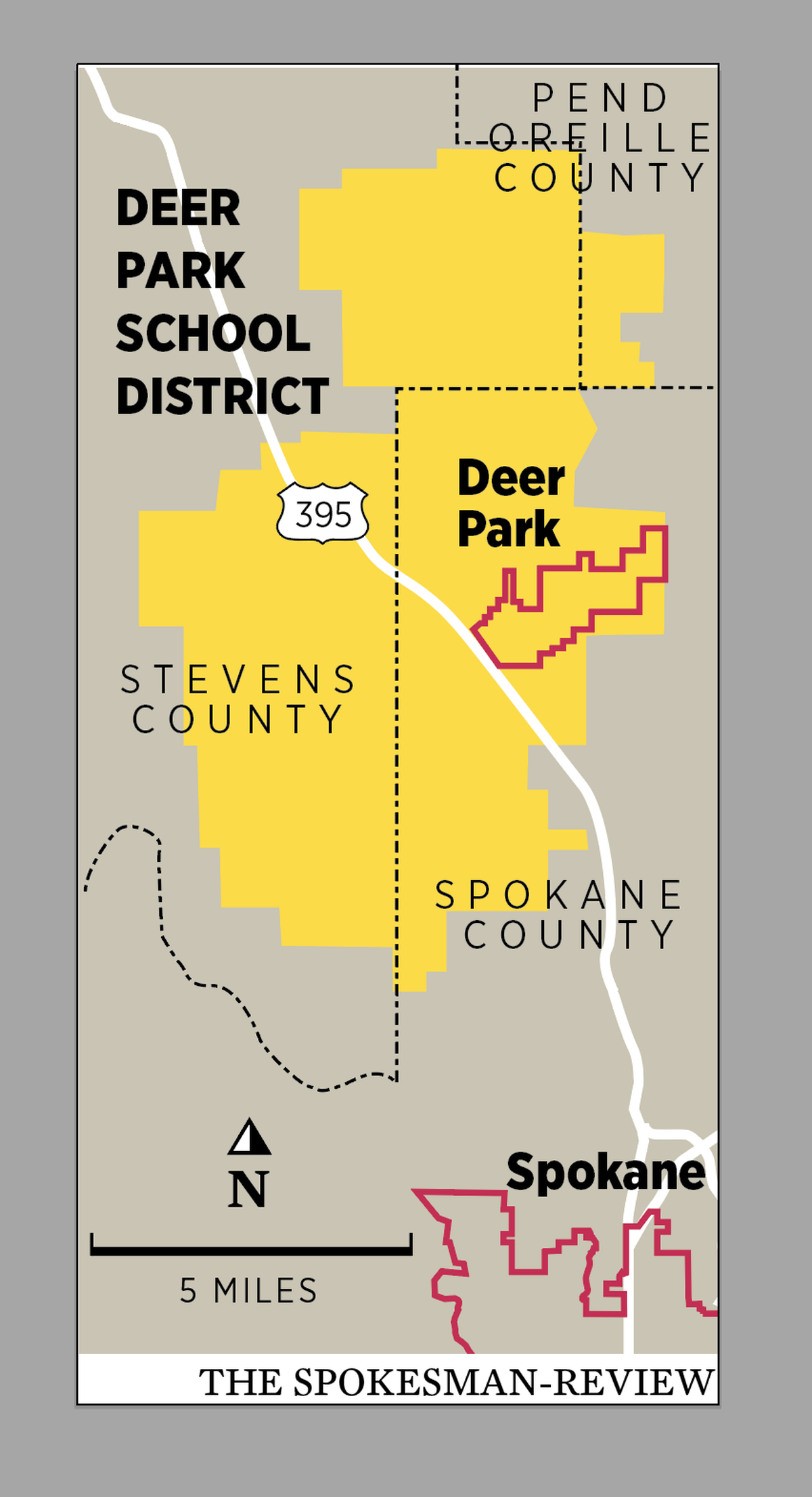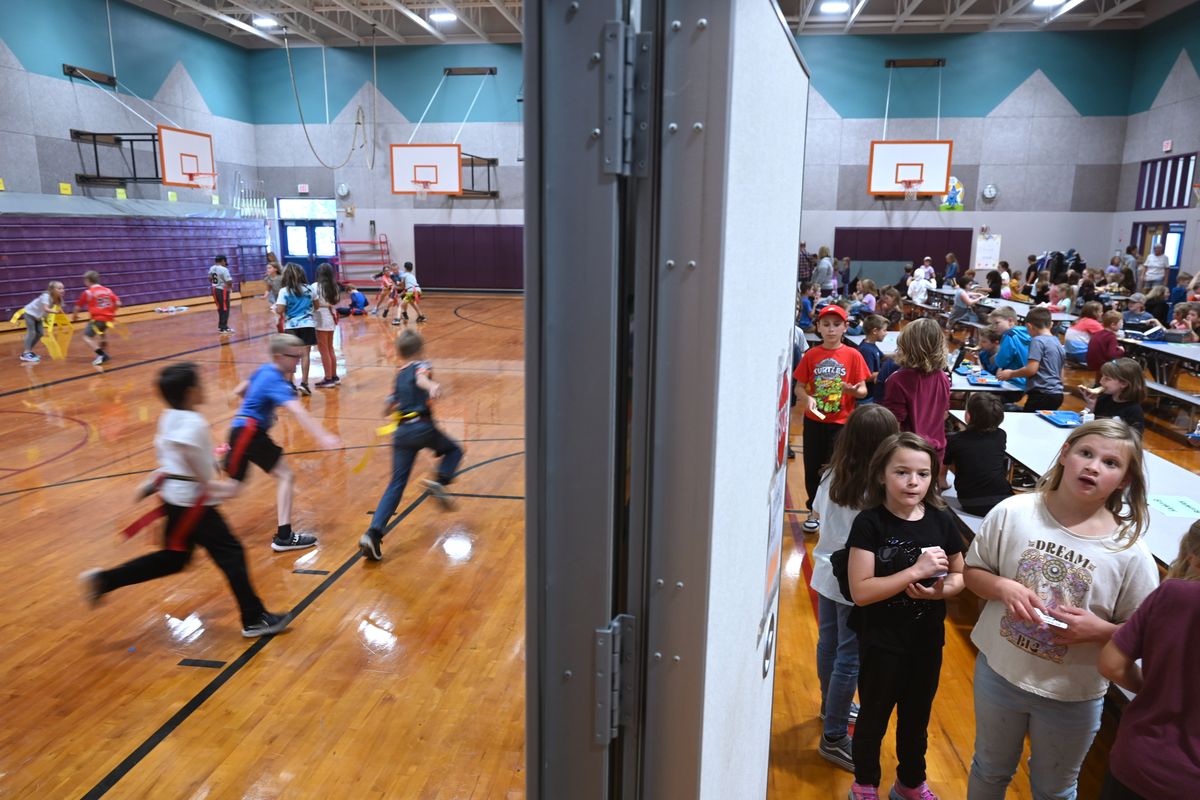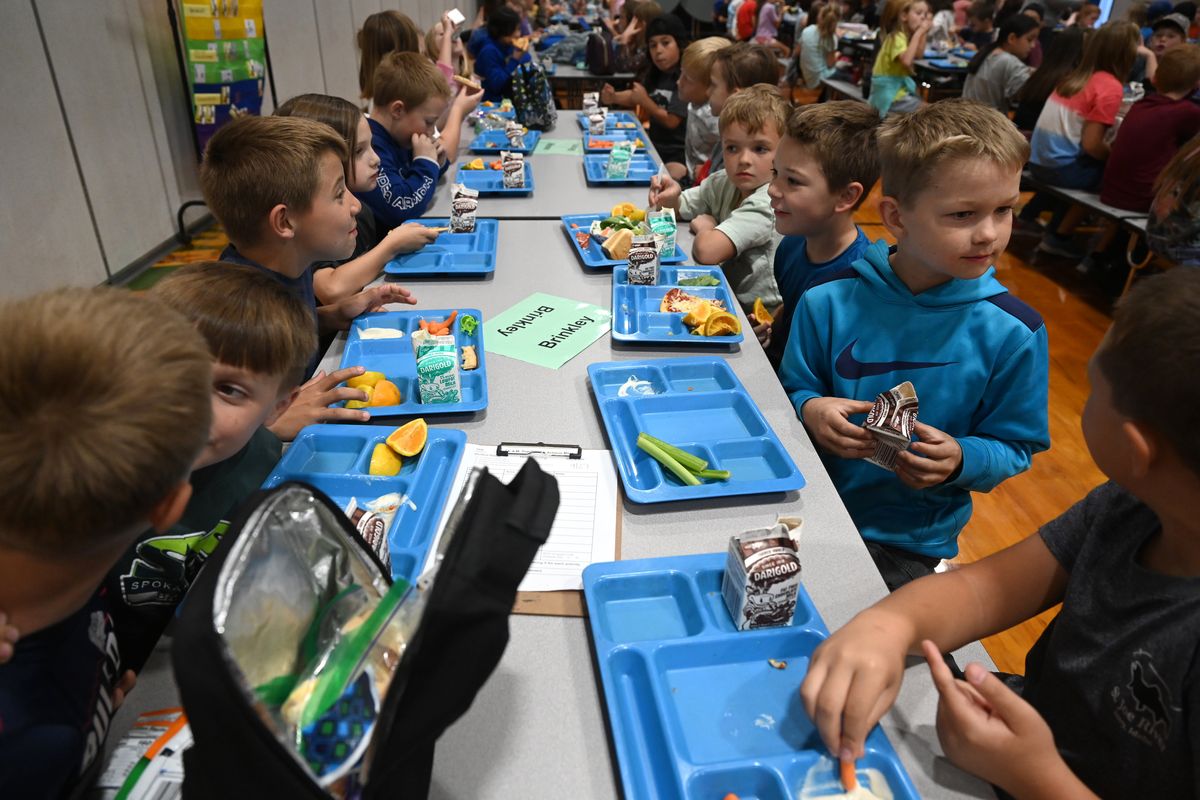As schools ‘bust at the seams,’ Deer Park school district seeks bond for new elementary school, bus barn
A physical education class takes place Friday at Arcadia Elementary in Deer Park, while students file in for lunch. The gymnasium is divided by a modular wall to make room for a cafeteria-style space in the school, which is dealing with an explosion in student population. (Jesse Tinsley/The Spokesman-Review)
The sturdy yet inviting 1970s-style brick and plaster single-story Arcadia Elementary School doesn’t clue passersby into the urgency and uncertainty felt by the staff inside the school.
But drive a couple miles in just about any direction from the Deer Park school and the hundreds of freshly constructed houses and signs declaring plots of land to be future neighborhoods offer a glimpse at what’s to come for an already-bursting Arcadia.
“These houses are going up so fast, we may be at capacity before the end of the school year; I don’t know that. I can’t predict with this growth,” said Arcadia Principal Lori Burke, shaking her head. “Do I think I can make it one more year? I think we can. I don’t know what two or three years looks like, but I can’t even promise we’ll make it that long.”
Deer Park, the rural town 20 miles north of downtown Spokane, is growing and so is the student body in the five-school Deer Park School District.
To brace for this population boom, district administration is hoping to make it six schools and seeking voter approval on a $55.1 million bond to build a new elementary school and transportation facility.
“Our schools also are growing and busting at the seams,” said Deer Park Superintendent Alexa Allman. “So we’re needing to plan and think for the future.”
If passed, the bond will tax property voters at an estimated rate of $1.26 per $1,000 in assessed property value over the 27 year life of the bond. When accounting for the levy currently on property owners’ bills, the full tax rate property owners pay towards Deer Park schools would be $2.76 per $1,000, if the bond passes. The district expects this rate to stay steady for the foreseeable future.
In 2023, property owners paid taxes to the school at a rate of $3.04 per $1,000, and in 2024 they’ll pay $2.70. Included in this bill are the payments toward the previous bond passed in 2008. These payments sunset after 2025 and would be replaced by this bond, if passed.
Johnathan Curley
Arcadia Elementary serves around 470 students in grades 3 through 5, though it’s intended to house a maximum of 350. District officials have added three past-their-prime portables installed outside the school to serve as six classrooms, and several rooms in the school have been converted to classroom space.
Without a new school, the overcrowding won’t stop there. The district forecasts an over 15% increase in pupils in kindergarten through fifth grade from this year to 2031; an increase from 919 to 1,048 students according to district projections based on surrounding residential growth and enrollment trends.
As Arcadia grows, Burke said there’s always the option of adding more portables for classrooms, but that doesn’t alleviate the strain on what few common spaces exist in the school.
“Sure, you gave me a classroom for (general education) kids, but now I need more special (education) staff, I need another nurse, I need a bigger gymnasium, I need another cafeteria.” Burke said. “The common space is my concern, not the classroom space.”
No room in Arcadia illustrates the overcrowding like the MacGyvering visible during mealtime. The school’s intended cafeteria was reconfigured to a special education service room before Burke’s time at the school, leaving kids to feast in the school’s gym.
At lunchtime, 160 pupils clamor at once into one side of the gym. A floor-to-ceiling divider splits the space in half: Kids chow down on pizza slices and chocolate milk on one side of the wall, while their lunchtime din is audible to the kids in PE class on the other side.
It’s even busier once a week, when staff oversee lunchtime and two gym classes all at once in the space.
“Imagine two PE classes crammed into a half of a gym, that’s kind of what it looks like in reality right now,” Allman said. “We’re trying to maximize every inch that we have of that school to make learning spaces for kids.”
Staff turned the library into an intervention room for students and the once-cafeteria became a multipurpose space that became a special education room. Other than the library, held in a much smaller, windowless classroom, and a music room, the school doesn’t have a multipurpose room since the special education classroom was needed.
“We used it for art projects and science projects, and classrooms could come up and use it,” Burke reminisced. “Then it was like, well, that luxury is gone because we needed a classroom.”
The new elementary school would be built on land the district already owns, nearby its existing schools all within a mile of each other. It would serve grades 2 through 5 and spur reconfiguration in their schools to adjust to overcrowding.
The current Deer Park Elementary would house preschool through first grade and Arcadia would become a space for the district’s Homelink program, a 600-student program in which home-schooled students can take classes through the school district. These kids currently work out of the school district’s administration building.
Deer Park was among the five Spokane county school districts whose bonds failed in February; their November ask is cheaper and includes fewer projects, reducing the ask by around $10 million. After several committee meetings and well-attended school board meetings, the district whittled down their project list to two high-priority needs, Allman said.
“We all came together, and we analyzed the feedback, we looked at the projects, we looked at the costs, we looked at the tax rates, we looked at the projected growth,” Allman said.
In addition to the school, another top priority is the district’s 100-year-old bus barn, converted from an old mill.
The current facility is only accessed by a pothole-laden dirt road over which drivers navigate school buses. Allman said the new facility would include amenities absent from the existing space, including internet access and a second sink outside of the bathroom for employees to wash their dishes in.
“It’s 100 years old, the old mill, so it’s definitely in an isolated space and it’s pretty dark out there,” Allman said.
“We also want to make sure that our bus drivers have a safe place to enter in and out, and it would also be more connected with the schools and the community.”
School Board member Gerry Ashby was absent from the vote to approve the resolution, though shared an assessment of the bond’s failure at a previous school board meeting on May 13.
Ashby said before the school district went for another bond, they should first better create and advertise a long- and short-term strategic plan pertaining to the district’s finances. He also advocated for a detailed breakdown of how much components of each project costs.
“We need to make the data available to the public, whatever they ask for,” Ashby said. “It needs to be simple, straight-forward, it has to be relevant, pertinent, consistent, accurate.”
Responding to Ashby’s assessment, board Chair Eric Keller said the district had a strategic plan and facilities planning was part of it. Allman said this plan had been put on the “back burner” while planning for the bond, but not for lack of transparency.
“We want to be as transparent as we can be, part of it for me was which information because it can go super deep, like the multipage reports we get, how much is too much? How much is not enough? What’s the ‘just right’ message?” she said at the meeting.
More information on the bond can be found on the school district’s website.





